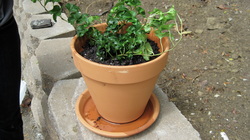to make something grow?
|
|
Green Thumb Plant Master! - A |
Yellow Green Thumb - B |
Yellow Thumb - C |
|
Evaluation of Evidence |
- Gathers evidence with regularity & writes down all available information - Considers all available evidence - Uses sight, touch, & even smell to evaluate plants - Realizes when outside factors might have compromised data (for example, if there has been little sunlight for a long period) |
- Gathers evidence fairly regularly and writes down most of what is observed - Considers some of the available evidence - Uses sight & touch to evaluate plants - Sometimes sees when outside factors might have changed data |
- Gathers evidence sometimes but often forgets to write down key observations - Begins to consider evidence, but does not use good evaluation skills - Uses only sight to evaluate plants - Evaluates evidence without regard to outside factors |
|
Analysis and Synthesis of Evidence |
- Thoroughly compares and contrasts others’ journal entries create context for own findings - Addresses evidence in journal entries & photos and compares these findings to test reliability - Recognizes that qualitative observations are variable & brings structure to these observations by using photo-to-photo comparisons |
- Compares some other classmates’ entries to own data - Sometimes checks both photos and journal entries to look at evidence with relative reliability - Recognizes that qualitative observations are variable & uses these sparingly or relies on others to make direct comparisons |
- Does not compare own results to others’ journal entries - Draws only from photos or journal entries and does not effectively synthesize information - Uses qualitative observations without effectively comparing these. |
|
Drawing Conclusions |
- Uses data to draw conclusions and refers to data in making his/her argument - Focuses on the data that is the most reliable & uses this information as a basis for drawing conclusions - Offers only opinions that are supported by the data |
- Sometimes uses examples from the data to make an argument in drawing conclusions - Focuses on mostly reliable data to draw conclusions - Offers opinions about water usage that are mostly supported by data |
- Only rarely uses examples from data in drawing conclusions - Does not focus on specific data in drawing conclusions - Offers no opinions or opinions that seem not to be supported by his/her experimental findings. |
|
Acknowledging Alternative Explanations and Viewpoints |
- Recognizes that this experiment does not provide a clear answer for all plants & offers ways to broaden the experiment - Looks to other reliable information sources for conclusions |
- Recognizes some problems with the experiment but offers no solutions - Looks at some other information sources, but does not necessarily integrate these in conlusions |
- Does not recognize any problems or offer solutions - Does not seek information from other sources |

